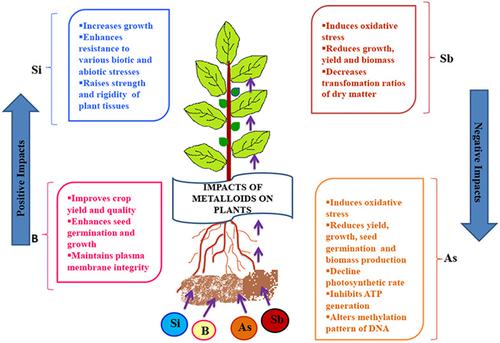当前位置:
X-MOL 学术
›
Ann. Appl. Biol.
›
论文详情
Our official English website, www.x-mol.net, welcomes your
feedback! (Note: you will need to create a separate account there.)
Metalloids in plants: A systematic discussion beyond description
Annals of Applied Biology ( IF 2.2 ) Pub Date : 2020-12-13 , DOI: 10.1111/aab.12666 Nishat Parveen 1 , Roberto Berni 2 , Sreeja Sudhakaran 3 , Javaid Akhter Bhat 4 , Suhas Shinde 5 , Naleeni Ramawat 6 , Vijay Pratap Singh 7 , Shivendra Sahi 8 , Rupesh Deshmukh 3 , Devendra Kumar Chauhan 1 , Durgesh Kumar Tripathi 6
Annals of Applied Biology ( IF 2.2 ) Pub Date : 2020-12-13 , DOI: 10.1111/aab.12666 Nishat Parveen 1 , Roberto Berni 2 , Sreeja Sudhakaran 3 , Javaid Akhter Bhat 4 , Suhas Shinde 5 , Naleeni Ramawat 6 , Vijay Pratap Singh 7 , Shivendra Sahi 8 , Rupesh Deshmukh 3 , Devendra Kumar Chauhan 1 , Durgesh Kumar Tripathi 6
Affiliation

|
Metalloids represent a wide range of elements with intermediate physiochemical properties between metals and non-metals. Many of the metalloids, like boron, selenium, and silicon are known to be essential or quasi-essential for plant growth. In contrast, metalloids viz. arsenic and germanium are toxic to plant growth. The toxicity of metalloids largely depends on their concentration within the living cells. Some elements, at low concentration, may be beneficial for plant growth and development; however, when present at high concentration, they often exert negative effects. In this regard, understanding the molecular mechanisms involved in the uptake of metalloids by roots, their subsequent transport to different tissues and inter/intra-cellular redistribution has great importance. The mechanisms of metalloids' uptake have been well studied in plants. Also, various transporters, as well as membrane channels involved in these processes, have been identified. In this review, we have discussed in detail the aspects concerning the positive/negative effects of different metalloids on plants. We have also provided a thorough account of the uptake, transport, and accumulation, along with the molecular mechanisms underlying the response of plants to these metalloids. Additionally, we have brought up the previous theories and debates about the role and effects of metalloids in plants with insightful discussions based on the current knowledge.
中文翻译:

植物中的准金属:无法描述的系统讨论
准金属代表了范围广泛的元素,其理化性质介于金属和非金属之间。众所周知,许多准金属,如硼、硒和硅,对植物生长是必不可少的或准必需的。相比之下,准金属即。砷和锗对植物生长有毒。准金属的毒性很大程度上取决于它们在活细胞内的浓度。有些元素在低浓度时可能有利于植物的生长发育;然而,当它们以高浓度存在时,往往会产生负面影响。在这方面,了解根吸收准金属所涉及的分子机制、它们随后向不同组织的转运和细胞间/细胞内重新分布具有重要意义。准金属的作用机制 植物中的吸收已经得到很好的研究。此外,已经确定了参与这些过程的各种转运蛋白以及膜通道。在这篇综述中,我们详细讨论了不同类金属对植物的正面/负面影响。我们还对吸收、运输和积累,以及植物对这些类金属反应的分子机制进行了全面的说明。此外,我们在现有知识的基础上进行了富有洞察力的讨论,提出了以前关于类金属在植物中的作用和影响的理论和辩论。我们已经详细讨论了不同类金属对植物的正面/负面影响。我们还对吸收、运输和积累,以及植物对这些类金属反应的分子机制进行了全面的说明。此外,我们在现有知识的基础上进行了富有洞察力的讨论,提出了以前关于类金属在植物中的作用和影响的理论和辩论。我们已经详细讨论了不同类金属对植物的正面/负面影响。我们还对吸收、运输和积累,以及植物对这些类金属反应的分子机制进行了全面的说明。此外,我们在现有知识的基础上进行了富有洞察力的讨论,提出了以前关于类金属在植物中的作用和影响的理论和辩论。
更新日期:2020-12-13
中文翻译:

植物中的准金属:无法描述的系统讨论
准金属代表了范围广泛的元素,其理化性质介于金属和非金属之间。众所周知,许多准金属,如硼、硒和硅,对植物生长是必不可少的或准必需的。相比之下,准金属即。砷和锗对植物生长有毒。准金属的毒性很大程度上取决于它们在活细胞内的浓度。有些元素在低浓度时可能有利于植物的生长发育;然而,当它们以高浓度存在时,往往会产生负面影响。在这方面,了解根吸收准金属所涉及的分子机制、它们随后向不同组织的转运和细胞间/细胞内重新分布具有重要意义。准金属的作用机制 植物中的吸收已经得到很好的研究。此外,已经确定了参与这些过程的各种转运蛋白以及膜通道。在这篇综述中,我们详细讨论了不同类金属对植物的正面/负面影响。我们还对吸收、运输和积累,以及植物对这些类金属反应的分子机制进行了全面的说明。此外,我们在现有知识的基础上进行了富有洞察力的讨论,提出了以前关于类金属在植物中的作用和影响的理论和辩论。我们已经详细讨论了不同类金属对植物的正面/负面影响。我们还对吸收、运输和积累,以及植物对这些类金属反应的分子机制进行了全面的说明。此外,我们在现有知识的基础上进行了富有洞察力的讨论,提出了以前关于类金属在植物中的作用和影响的理论和辩论。我们已经详细讨论了不同类金属对植物的正面/负面影响。我们还对吸收、运输和积累,以及植物对这些类金属反应的分子机制进行了全面的说明。此外,我们在现有知识的基础上进行了富有洞察力的讨论,提出了以前关于类金属在植物中的作用和影响的理论和辩论。











































 京公网安备 11010802027423号
京公网安备 11010802027423号